Hi again….. this was quite a challenge!
Hope you enjoy!!!
DETERMINED TO STAND: The Reinvention of Bob Dylan is available as a book, ebook or audio book
——————————————————————————–
…A messenger arrived with a black nightingale….


Changing of the Guards, which opens 1978’s Street Legal is one of Bob Dylan’s richest creations. Each line throws out another luminescent image, almost every one of which is open to symbolic interpretation. The song is one of Dylan’s great ‘epics’, bearing comparison to A Hard Rain’s a-Gonna Fall, Desolation Row, Visions of Johanna, Tangled Up in Blue and Jokerman in terms of ambition. Like these songs, it marries the personal and the universal, seamlessly mixing poetic and colloquial language and showing us scenes in the poet’s mind from a range of shifting perspectives. In some ways it follows on from the ‘cinematic’ songs on the previous album Desire. But if this song is a ‘movie’ it is constructed almost entirely of ‘jump cuts’, throwing us from one scenario to another with reckless abandon. It is also, if performed in the right spirit, a great rock song, whose verses are linked by a very hummable riff, which works best if it is attacked. Dylan performed the song many times on the 1978 world tour, backed by his ‘big band’ which included a saxophone player and female backing vocalists, possibly inspired by the brilliant contemporary live shows of Bruce Springsteen and Bob Marley. The recording on the album is marred by slightly ‘muddy’ production but as Dylan develops the song throughout the tour it builds and builds into one of his most powerful creations. By the time he reaches Charlotte, North Carolina on 10th December – by consensus the greatest show of the year – he has turned it into a loud, heavy and triumphant ‘wall of sound’. There are also some worthwhile covers. Patti Smith does a good job, although her version is perhaps a little too reverential. The Gaslight Anthem and Frank Black, however, both less in awe of the lyrics, treat the song as a delirious ‘kick ass’ piece of rock’n’roll, building it up into a series of furious climaxes.

The song presents a series of very powerful images, linked with a dream-like logic, in a way that foreshadows much later work like Ain’t Talkin’ or Key West. Like many of those later songs, it is focused partly on the endless struggle an artist has to go through in order to connect to his or her poetic muse. It also uses symbolism and shifting narrative perspectives to relate the story of a ‘tangled’ relationship, much like the songs on Blood on the Tracks. At the same time it speaks to universal concerns, almost as if it is a ‘follow up’ to A Hard Rain’s a-Gonna Fall, a ‘parade’ of unforgettable visual images culminating in the poet surveying the world from mountain top’ and refusing to hide away underground in the face of the threat of armageddon. Changing of the Guards is more ambiguous, but equally apocalyptic in its implications. As the images it presents us with are so pointedly symbolic, it may be that every listener will divine a different meaning from the song. Dylan certainly seems to be communicating with us here on several levels at once. In a 1978 interview with Jonathan Cott he commented that:
…’Changing of the Guards’ is a thousand years old. Woody Guthrie said he just picked songs out of the air. That means they were already there and that he was just tuning into them. ‘Changing of the Guards’ might be a song that might have been there for thousands of years, sailing around in the mist, and one day I just tuned into it…
The symbolism of Changing of the Guards draws on a number of sources, including the Bible and the tales of Gods, demigods and heroes of ancient Greek mythology. The influence of the Romantic poets is noticeable, especially Keats’ unfinished epic Hyperion, which is set in the symbolic landscape of the ancient Greek mythos and which describes how the old Titanic gods are replaced by the Olympians such as Jupiter, Neptune and Pluto. Hyperion himself is displaced by Apollo, who places particular value on music and poetry. Writing at the height of the Industrial Revolution, Keats uses this symbolic framework to state his belief that the power of the human imagination will triumph over the old superstitions. The sun god’s ascension to his new ‘throne’ is overseen by the Titan Mnemosyne, the Mother of Muses who in 2020’s Rough and Rowdy Ways Dylan will later announce his devotion to. There had been hints of Dylan’s interest in ancient mythology on the previous album Desire (1976), on which Isis (another dreamlike ‘epic’) features a personification of his lover as an Egyptian goddess. In Sara, his song of despairing but hopeless devotion to his wife which concludes the album, she is described as a …glamorous nymph with an arrow and bow… so identifying her with Artemis the Greek goddess of hunting and protector of women.

JOHN KEATS
The song also demonstrates the fascination which Dylan had recently developed for the powerful imagery of the Tarot, which is also apparent on other songs on Street Legal such as No Time to Think and We Better Talk This Over. Dylan has always been fascinated by the random qualities of playing cards, as expressed in early songs as Rambling Gambling Willie and Blood on the Tracks’ comic western fantasia Lily, Rosemary and the Jack of Hearts. The Tarot has a very long history going back to early modern times. In the late 18th century it began to be used for purposes of divination. It has gained much popularity in the modern era among followers of ‘New Age’ and ‘hippie’ movements who are seeking for alternative forms of spirituality. The use of the cards is often misunderstood to be a crude form of fortune telling. In fact, modern users of the Tarot (of which Sara Dylan was one) will lay out the cards in a random sequence – sometimes following a set pattern and sometimes a pattern of the individual’s own choosing – and meditate on both the symbolic meaning of the images and the connection between them that has been established by how they are laid out. The images themselves present archetypal ‘mortal and immortal’ figures which symbolise the whole range of situations which an individual may find him or herself to in. By recognising the archetypal patterns which the images represent, the acolyte can then confront certain psychological patterns that may lie buried within their own psyches.

CARL JUNG
Carl Jung believed that the cards might provide ways to unlock the secrets of the unconscious mind. In a 1933 lecture he stated that:
…man always felt the need of finding an access through the unconscious to the meaning of an actual condition, because there is a sort of correspondence or a likeness between the prevailing condition and the condition of the collective unconscious…
One of the main purposes that a modern Tarot reader may use the cards for is to confront issues of change. The ancient Chinese text I-Ching is often used for similar purposes. Dylan’s interest in this area is indicated in the early ‘New York’ version of Idiot Wind from Blood on the Tracks where he actually describes having ’thrown’ the coins used for this book of divination. Having been through the life-changing experience of divorce in subsequent years, he now seems to be searching for ways to adapt to changes in his life. Here it as if he has laid out a ‘spread’ of Tarot cards and has constructed a symbolic story told through the images presented to him. The title of the song does not refer to the Tarot (although it sounds like it might!) but to a popular metaphorical saying based on the famous ceremony which tourists flock to see within the gates of Buckingham Palace – the idea of ‘changing of the guards’ implies a deep and complete change of situation or mental attitudes.
The song has nine verses. Each one begins with a short statement, followed by four lines in irregular metre. The rhyme scheme is also somewhat irregular. The third and fifth lines mostly rhyme but the second and fourth lines only rhyme in five of the verses. The effect of this is to force the listener to focus on the rich lyricism of the song and the rather extraordinary twists and turns that the lyrics take. The opening …Sixteen years… has been taken to represent the number of years Dylan has been a recording artist. It is also roughly the time between the composition of Hard Rain and Changing of the Guards. Thus the song may be taken to be, on one level, a kind of ‘self portrait’, tracing Dylan’s personal history through his career. The following …sixteen banners united over the field… appears to place us on a medieval battlefield. We hear that the …good shepherd grieves… over the fact that these ‘desperate’ men and women are divided. There is an obvious reference to Jesus here, which along with the other Biblical reference some have seen as a prelude to the religious conversion which Dylan would experience at the end of the year. But here the ‘good shepherd’ appears to have no real power here to halt the carnage, and will play no further role in what follows. He merely hovers over the scene like a figure in a medieval painting.

The next five verses of the song are presented as a dream-narrative, in which a series of highly resonant images flash before the narrator’s eyes. Many of these come from the Tarot, as if the narrator is laying out a series of cards and then placing himself inside the images, which then come alive, like the playing cards in Alice’s Adventures in Wonderland or Lily, Rosemary and the Jack of Hearts. First he draws the ‘Wheel of Fortune’. In the standard ‘Rider-Waite’ version of the cards (first published in England in 1910), this card is centred on a large wheel, engraved with the letters ‘TORA’ and surrounded by the figures of a snake and two Egyptian gods – Typhon, who represents evil and Anubis, who welcomes souls into the underworld. Surrounding them are winged figures representing the four fixed signs of the Zodiac – an angel (Aquarius), an eagle (Scorpio), a lion (Leo) and a bull (Taurus). Declaring that …fortune calls… the narrator steps …into the marketplace… which is full of …merchants and thieves, hungry for power… But the Wheel of Fortune symbolises shifting circumstances. Even though his ‘last deal has gone down’ he knows that the Wheel will eventually turn. Here, perhaps, is the young poet, tentatively stepping into the commercial music business, hoping to make the world aware of what is happening on that battlefield. Perhaps, he hopes, the winged figures will protect him. The resonant phrase …My last deal gone down… a staple of many blues songs, which Dylan later adapts for his own When the Deal Goes Down (2006), a meditation on mortality, may indicate that he is down on his luck. Maybe this represents the young singer, blowing his harmonica for ‘a dollar a day’ in the icy New York winter. On another level, it may suggest that he has actually died on the battlefield and that that the surreal world of shifting images he has entered is some form of afterlife. He is with the gods, perhaps, on Olympus.
The narrator immediately encounters the woman who he will pursue throughout the song in his own heroic quest. She seems at first to be representative of all that is good and natural. Like the female figures in so many of Dylan’s ‘visionary’ songs she may well represent his poetic muse. She is certainly elusive, a shape-shifter who continually changes form as the visions pile up. The narrator is entranced by her scent and her beauty and transfixed by her elusiveness. It is suggested that she may be a kind of earth goddess …She’s smelling sweet… he tells us, already going into an erotic reverie …like the meadows where she was born…
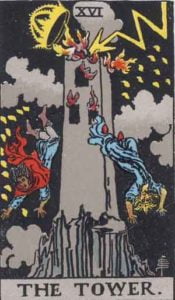
Then we are on to the next card. We hear that her birth has occurred in difficult circumstances …on midsummer’s eve, near the Tower… The Tower card portrays disaster. It seems to have been struck by lightning and people are desperately jumping out of the windows. Midsummer’s eve, like Halloween, is traditionally thought to be a time in which witches and other spirits are active. The implication is that the woman is the spawn of supernatural forces. But he is inexorably drawn to her, despite the obvious danger that she represents. She may smell seductively ‘sweet’ but she is notoriously capable of driving her lovers into states of delirium while she remains impassive. In the next line we hear that she is standing under …the cold blooded moon… The ‘Moon’ card depicts a full yellow moon with an angry face with two wolves baying beneath her. The figure of the moon in the Tarot represents illusion and deception. It seems that this spirit-woman may be leading him towards an uncertain fate. But the next card, ‘the captain’, which we might identify with the narrator, represents something more optimistic. He is confident that his love …will soon be repaid… He confesses his love for this …beloved maid/ Whose ebony face is beyond communication… Perhaps she is another manifestation of Isis, the Egyptian moon goddess.

As the song gathers pace we are presented with more and more outlandish, vivid imagery, much of which is Tarot-related. In the next verse the woman’s head is shaved, suggesting that she has been captured and is about to be tortured or killed as a witch. We are told she is ...torn between Jupiter and Apollo…. two Olympian gods. In some Tarot packs ‘Jupiter’ is the name given to a figure called ‘The Hierophant’, a teacher and dispenser of wisdom who is often associated with the wheel of fortune. The Sun God Apollo, who we will meet again soon, is associated with both music and better times ahead. Perhaps the young poet is similarly ‘torn’; not sure whether to pursue a life of intellectual vigour or one of potentially destructive hedonism. Or perhaps whoever is between these two forces will be ‘torn’ apart. Thus, in his dreamlike state the narrator identifies himself with the sun and the elusive female as the moon. In reality, of course, the sun will never ‘catch’ the moon – both must co-exist in order for the cosmos to remain stable. The poet must forever chase his muse across the firmament. She will always be slightly out of his reach.

In one of the song’s most memorable images we are then told that …A messenger arrived with a black nightingale… a beautiful succinct and highly suggestive line. Nightingales have featured in entire history of literature and song as far back as Homer. In more recent years they became staples of romantic songs. Generally they have come to symbolise purity and goodness. The Romantic poets associated them with creativity and nature. In Keats’ opium dream Ode to a Nightingale the bird represents the sprit that will fly out of him after his imminent death. The narrator’s own journey is becoming rather similar to that of Keats, ‘as if of hemlock he had drunk’. A nightingale is normally a sign of hope. But here the ‘black nightingale’ is ambiguous. Perhaps this mysterious goddess has manifested herself in this spectral form. The narrator declares that he is inexorably drawn to follow her …down past the fountain, where they lifted her veil… But this time we are not given a glimpse of her ‘ebony face’.
In the next verse we are jolted back to the battlefield where the song began …I stumbled to my feet… the narrator tells us …I rode past destruction in the ditches/ With the stitches still mending ‘neath a heart shaped tattoo… In the Rider Tarot the Three of Swords depicts a heart being pierced simultaneously by three swords. Perhaps this is the tattoo be carries as a sign of devotion to his dream-woman. He is still wounded from his exploits in the battle. The image of the Three of Swords represents the pain that the words and actions of another can inflict on ‘the heart’. This is followed by another extraordinary image, in which …Renegade priests and treacherous young witches/ Are handing out the flowers that I’d given to you… These corrupt figures are seen here mocking his expression of love for her. The poet’s pursuit of his muse has been subverted by his followers – some who ascribe spiritual meaning to his work and others who wish to exploit him sexually in order to gain access to his wealth and fame.
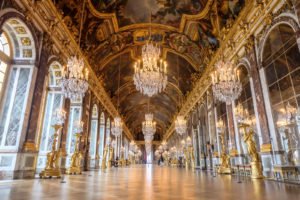
THE HALL OF MIRRORS
The sixth verse presents perhaps the most remarkable dream-vision in the entire song. We now begin to move away from the Tarot imagery, as the narrator begins to perceive his surroundings with hallucinatory intensity. We are now in a vast … palace of mirrors… a fantastical building, perhaps, in which an individual’s every movement is mirrored in a thousand different shifting reflections. Perhaps we are in the Hall of Mirrors in the Palace of Versailles, where the notorious Treaty of Versailles was signed at the end of the First World War. The treatment of Germany in this treaty was so harsh and punitive that it led to a collapse in the German economy and, some would argue, the later rise of Hitler. This is a place where …dog soldiers are reflected… The ‘dog soldiers’ were a band of Cheyenne warriors who carried out a hopeless fight against their white conquerors in the mid nineteenth century. Thus we are presented with images of the bitter futility of human conflict, depicted here as an …endless road… The rather surreal image of the …wailing of chimes… suggests the lamentations of those who have lost loved ones in wars, amplified by the ringing of church bells; echoing Dylan’s own late-protest lament Chimes of Freedom. We are led into …The empty rooms where her memory is protected… Here we hear the voices of ‘angels’ whispering …to the souls of previous times… as if the invisible ‘angels’ are saying prayers for the many dead who have fallen prematurely in war throughout the ages. To say this is a ‘haunting’ line would be an understatement.

PROMETHEUS
The first, abrupt, line of the seventh verse …She wakes him up… jolts us out of this fantastical dream. It is two days later and …the sun is breaking… To signify this sudden change, we switch pronouns. This is reminiscent of the shifting pronouns in Dylan’s great ‘cubist’ song about a doomed relationship Tangled Up in Blue, in which the constant changing of narrative perspectives takes us in and out of intimate contact with the subjects of the song. The sun is described not as ‘rising’ but ‘breaking’, as if the sky, or the cosmos itself, is breaking open. In Chimes of Freedom we heard that …the sky cracked its poems in naked wonder… Now we appear to be on a mountain side, but not one he can, like the ‘blue eyed boy’ of Hard Rain, preach from. In the next line we are (almost literally) bombarded by a series of images from Greek mythology: …broken chains, mountain laurels and rolling rocks… showing us first Prometheus Unbound – the figure who steals fire from the gods and gives it to man and who is then chained to rocks for all eternity. Shelley’s play Prometheus Unbound depicts the bringer of fire as escaping from his chains, which symbolises humanity breaking free from the religious and social dogmas of the past) through the power of the poetic imagination. The mountain laurel is a tree that grows in the USA, but in Greek mythology the laurel has a prominent place. In a story that was considerably embellished by the Roman poet Ovid in his Metamorphoses, the nymph Daphne – who is dedicated to preserving her chastity – is pursued by Apollo with great fervour. Eventually in his frustration he turns her into a laurel tree. Feeling rather guilty about this, he swears to protect laurel trees, which as a result are evergreen. Laurel leaves and wreaths were presented as prizes to military and artistic heroes, which is where the term ‘poet laureate’ came from. ‘Rolling rocks’ appears to refer to the myth of Sisyphus, an errant king who the Gods punished by forcing him to roll a huge boulder up a hill for all eternity. But he could never get the stone to the top as it would always roll back down.

SISYPHUS
Thus, as he is woken up, the narrator is presented with a number of mythical scenarios. Prometheus, Daphne and Sisyphus – three figures who represent different forms of psychological entrapment – are all imprisoned for eternity in their punishments. Jung argued that the Prometheus myth symbolised the danger of the human ego being separated from the collective unconscious, a problem which is solved when Prometheus is freed by the hero Hercules. In Dylan’s film Renaldo and Clara (also released in 1978) the pinball-playing ‘Greek chorus’ figure David Blue refers to The Myth of Sisyphus, a 1942 essay by the French existentialist novelist Albert Camus, in which Camus argues that a myth which is normally taken to represent the futility of repeating a failed method can be seen as positive. As the stone rolls down the hill, Sisyphus has no choice but to accept his fate by distancing himself from it psychologically. Therefore melancholy is turned into joy. Such a transformation is now about to take place. The myth of Apollo and Daphne is often seen as a battle between chastity and lust, or between emotions being blocked and frustrated. It now seems that in the ‘dream’ section of the song (the first six verses) the protagonist may well be Apollo and Daphne may be the elusive figure he has been unsuccessfully chasing. But now he has woken from his dream. And everything is about to change.
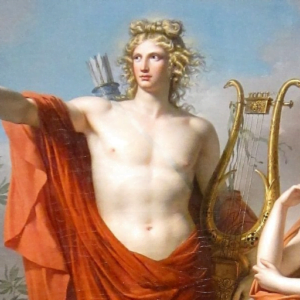
We now switch into the continuous present tense, as if this is a film script. We hear that Daphne (if this indeed is her) demanding that our protagonist should take dramatic action to change the world. His response is portrayed in the brilliantly cinematic image of …He’s pulling her down and she’s clutching onto his long golden locks… Here Daphne willingly surrenders her virginity, pulling on his angelic blonde hair in her ecstasy. The union of the two, so long desired by our hero Apollo, gives him great fulfilment and the determination to summon up the courage to demand changes that he – as the most powerful of the gods – actually has the power to bring about. This is the bit, of course, where the band should really rock out and where the guitarist has full rein to knock off a fluid solo. The ‘big bang’, so to speak…
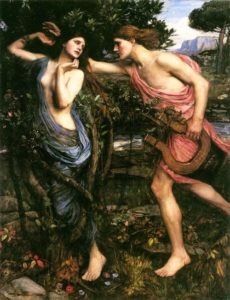
DAPHNE AND APOLLO
The last two verses consist of a highly rhetorical speech which our Apollonian hero presents to the other gods. In a bizarre twist, he addresses them formally as if they are a group of businessmen, politicians or even Mafia bosses, while delivering an unequivocal ‘offer’ to them which they would be very unwise to refuse: …Gentlemen, he said… I don’t need your organization… he tells them, sarcastically piling on the alliteration ...I’ve shined your shoes/ I’ve moved your mountains and marked your cards…. Now his tone could be seen as threatening. He clearly no longer needs to defer to them. Then he makes a crucial statement. He tells us that …Eden is burning… and then, still talking at first like a gangster, delivers the clear threat: …Either brace yourself for elimination… Then we get the coup de grace: …Or else your hearts must have the courage for the changing of the guards… He is fully awake now, having awoken from his dream, and is now addressing those who wield power in the world. He demonstrates that, unless they change their ways, the apocalyptic destruction of the ‘paradise’ of the Earth will be at hand.
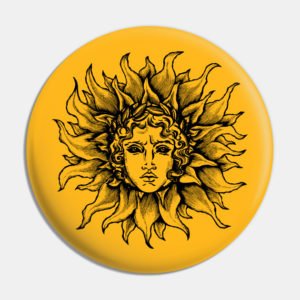
The final verse, with its quite magnificent and dexterous use of dramatic and visionary language, appears to complete the speech …Peace will come… the narrator states, now assuming a prophetic role …with tranquillity and splendor/ on wheels of fire… There is a passing reference here to the prophet Ezekiel’s vision of heavenly spiritual transcendence. The allusion may also be to one of King Lear’s final speeches, in which he declares his submission to fate: …I am bound upon a wheel of fire that mine own tears/ Do scald like molten lead… Both interpretations may be valid here. It seems that the narrator has now assumed Apollo’s godlike powers and is telling the ‘gentlemen’ that a new millennial age is on the horizon. He appears to be sweeping away all the centuries of war and ‘declaring peace’ for all eternity to come. But this vision is immediately undercut. It seems that the figure of ‘Peace’ is another mythic personification, perhaps of the goddess Eirene, a beautiful woman who carries a sceptre – another manifestation of the muse the narrator has been following. We hear that she …will offer no reward, as her false idols fall… The narrator seems to be inferring, perhaps in a threatening way, that the ‘gentlemen’ can expect no special treatment when Peace arrives.

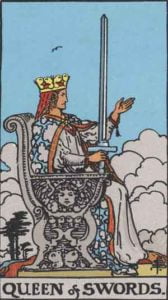
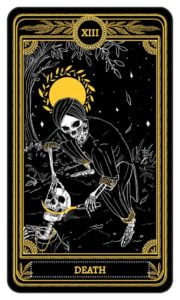
The song’s final image is perhaps the most resonant of all: …and cruel death surrenders/ With its pale ghost retreating between the King and the Queen of Swords…. Here we are clearly back in the symbolic realm of the Tarot. Both the King and Queen of Swords represent rationality and fair judgement. Thus image of ‘cruel death’ retreating between these two figures is a remarkable one. It suggests that, having finally ‘consummated’ his love for his muse, the poet may have achieved a kind of immortality. On a more universal level, the image may represent the ultimate triumph of peace over war. But the much-feared ‘Death’ card in the Tarot is often misunderstood. It may signify destruction but it is actually more likely to indicate the ‘death’ of old ways and the opening up of new possibilities – the ‘changing of the guards’. Thus, the certainty of change may be being celebrated here. Or those changes will merely fade away when confronted with the ‘rulers’ of rationality. A new era of spiritual fulfilment may be about to dawn – or a new era of crushing materialism. The Tarot cards do not ‘predict’ the future. They merely lay out the possibilities, presenting us with archetypal images that can be ‘read’ in many different ways. Thus the ultimate ‘message’ of the song seems to be that a poet – or any one of us – needs, throughout his or her life, to learn to confront the forces of love, death, innocence, evil, justice and betrayal. We will all interpret the ‘cards’ we draw’ in life in different ways. But in that interpretation lies the difference between peace and war, love and hate, success and failure. One thing is certain though – we must always be prepared to accept change – in our lifestyles, in how we practice our arts or how we relate to others. Our whole lives, as we grow through the ‘seven ages of man’, are a process of metamorphosis. In order to keep progressing we need to be strong and fearless. Our hearts must have the courage, indeed, for the ‘changing of the guards’…

DYLAN LINKS
DAILY DYLAN NEWS at the wonderful EXPECTING RAIN
THE BOB DYLAN PROJECT- COMPREHENSIVE LISTINGS
THE CAMBRIDGE BOB DYLAN SOCIETY



Leave a Reply